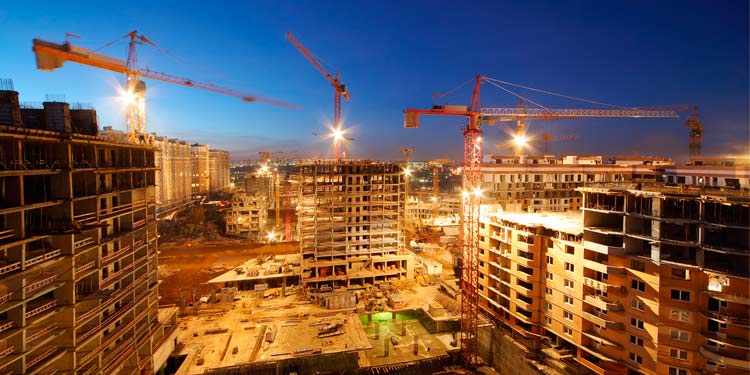The main industries that rely on two-way radio communication vary from construction, aviation, logistics and even schools. Below, you will find out how these sectors benefit from the efficiencies of instant communication and what features they require from professional walkie talkies.
Efficient communication for any business is a must. Not only does it speed up operations, but it can also save money. Naturally, you would think a mobile phone would be the quickest and cheapest way to reach colleagues wherever they may be. However, signal coverage blackouts, low durability, low water resistance and the cost of SIM plans can make them the more costly and less sensible mode of communication in the long run.
In this article, you will see what features large industries need from their two-way radios, and how this might benefit your business too.
1: Construction
Construction environments vary considerably. Whether you are working on a small building site or large multi-department and multi-team infrastructure project, professional walkie talkies are vital to ensure the safety of your colleagues and keeping site activity running as smoothly, efficiently and cost-effectively as possible. Two-way radios are preferred over mobile phones in the construction industry for their high level of dust and water resistance. To find out how resistant your professional walkie talkie is, refer to the IP rating in the walkie talkie descriptions. If durability is crucial for you, then a radio with military standard specifications is worth looking into.
Also, radios which are UHF (Ultra-high frequency) enabled have signals which can penetrate thick concrete walls and barriers. This means that you can stay in contact no matter what physical obstructions may be found around you. A multi-channel radio is also favoured by those working in construction as you can communicate simultaneously or quickly between a multitude of divisions or departments through the same radio whilst minimising unnecessary conversation which does not concern you.
Furthermore, if workers will be working on their own in a high-risk environment, it would be worth looking for a handset with a lone worker or man down function. Lone worker function demands a response from a user via pressing the PTT button for example to signal that he or she is safe. Man down however allows you to monitor workers if they are not moving, moving too much or if their radio is placed at an angle for an unusual period of time.
Key features to look out for:
UHF
Multi-channel
High IP Rating (IP67/68)
Lone worker/man down function
US-MIL-STD-810
industries that use walkie talkies
2: Aviation
Aviation operations and airport services need to run like clockwork. Delays and disruptions are timely and costly for all parties involved so constant and frequent communication is pivotal for airlines and ground crews alike. With airports being usually large and flat, they provide ideal conditions for long distance radio communication. A VHF (Very high frequency) radio is preferred at airports for their exceptionally wide range, however airports are not as obstruction free as many may think. With a multitude of airlines, and ground service companies communicating with their own sub-teams via radios, an airport is perhaps one of the worst environments for radio interference.
To avoid this, the purchase of a licensed two-way radio is recommended, which minimises disruption and allows you to communicate with your team on secure frequencies. In the UK you are required to purchase a radio license from OFCOM, the British regulatory body for communications. It comes at a cost of £75 for 5 years and enables you to apply as many radio handsets to the license as you wish.
If frequency security is a real priority for you, then looking at a hybrid digital/analogue two-way radio may be the best option as these handsets scramble your frequency, making interference very difficult for outside users. Also, a radio with a squelch function would be ideal. This enables a radio to suppress the sound of outside channel noise when it is not receiving a transmission.
Key features to look out for:
VHF
Multi-channel
Licensed two-way radio
Hybrid digital/ analogue radio
Squelch function
industries that use walkie talkies
3: Warehouses & Storage
Vast warehouses or storage depots means that employees will mean that communication can sometimes be slow and difficult. Therefore instant communications can speed up operations, productivity and workplace efficiency. As workers could be working at a height or around machinery in a warehouse, radio durability is important. A robust or military standard radio would be best for large and busy warehouses.
For an ideal range, a two watt radio (2 miles of coverage under no obstructions) will provide adequate coverage. However for larger warehouses with more obstructions such as stocked items and thick walls, a radio with a higher wattage would be able to provide a clearer and stronger connection if necessary. A UHF radio operates well in both indoor and outdoor environments and would be appropriate for a warehouse alongside a channel range which that suits the size of your operations.
Key features to look out for:
MIL-STD-810
UHF
2+ Watt Range
4: H ealthcare
ealthcare
Getting a patient to see the right person at the right time is a priority and health clinics and public hospitals alike. Many practices and public health institutions are not only using two-way radios to communicate instantly with others, but for their ability to emit an emergency tone in critical circumstances.
Most medical offices are finding that two-way radios are creating efficiencies that are simply not possible with conventional forms of communication such internal telephone lines and intercoms. In terms of specifications, a relatively inexpensive consumer walkie-talkie is the best option for most clinics and healthcare centres. An unlicensed two-way radio, which is UHF enabled, provides range and battery life for daily use. However, large health institutions with spanning multiple buildings and floors should seriously consider buying radios with an enhanced battery life and range. A more professional radio may be more suited to ensuring efficient communication.
Key features to look out for:
UHF
Unlicensed two-way radio
Emergency tone
Repeater capable
5: Security
Without radio communication, anyone who works in security recognises that their job simply is not possible. Efficient and discreet communication between security staff ensures the safety of their clients, the general public and themselves. A radio will also allow them to react to emergency situations swiftly, alongside any other incidents that need immediate attention.
The type of radio someone might need in the security field varies significantly. Security workers use UHF walkie-talkies mainly for its versatility indoors and outdoors. For those working prolonged hours and speaking frequently via two-way radios, a high powered professional model is recommended. A radio with an emergency tone function is also something you may need from your handset.
Moreover, if you work in outdoor security, the distance in which you will be communicating is fairly significant. A VHF radio may perhaps be more appropriate due to their extended range. This would be ideal for airport or outdoor events security for example. Privacy whilst communicating is naturally something you will need, so a licensed two-way radio which can emit a digital frequency would be preferable. Also, purchasing earpieces for your two-way radio is important for those who want to maintain discretion.
Key features to look out for:
UHF – for both close/medium-range indoor or outdoor use
VHF – for long range outdoor use
Emergency tone function
Licensed two-way radio
Digital two-way radio
Earpiece
6: Hospitality & Restaurants
From reception to laundry services, or waiting staff to back of house, running a hotel or a restaurant well is contingent on a combination of hard work, organisation and seamless communication between everyone who works there. It goes without saying why the hospitality sector relies on radio communication on an hourly basis and therefore requires a two-way radio.
Consumer radios are appropriate for a restaurant as range and power are not of major concern in a small environment. However buying a hands-free kit for your staff in a restaurant would be a smart choice safety and efficiency wise. However, selecting the right radio for a hotel requires more thought. For example, hotel sizes range from high-rise skyscrapers to 1-2 floor guesthouses.
For a large hotel with many floors and layers of concrete, a high-powered UHF radio is essential to maintain communication. Subsequently, a high-powered professional radio is the best option for hotels as such. Even still, it may be worth looking for repeater capable radios for an even more extended range to penetrate through concrete. Not to mention, the wide variety of channels they offer would be useful too for various departments in a large hotel.
Key features to look out for:
UHF
Unlicensed radio
Hands-free kits
Repeatable capable radios
Multi-channel
7: Retail
Retail stores can become extremely hectic during peak trading hours. From customer service, to fitting rooms to calling for more staff to man the tills, you need to respond to any problems on the shop floor swiftly in order to avoid unsatisfied customers and queues. Poor communication can equate into poor profitability in retail stores. Therefore it is essential that all staff members speak to each other as soon as potential issues arise.
Consumer radios are appropriate for small stores as range and power are not of major concern. As mentioned previously, purchasing a hands-free kit will allow staff to continue their work with minimal disruption whilst you communicate with them. As a result a high-powered UHF radio are popular amongst larger department stores with multiple floors and thick walls.
Key features to look out for:
Consumer radio
Hands-free kit
UHF
High power (2-4 watts)
Multi-channel
 8: Education
8: Education
Schools have increasingly become one of the biggest user groups for two-way radio communication as part of their daily activities. Whether if it is to monitor students during break times or contact caretaker or maintenance services, they have become an integral part of the school day. Walkie talkies also have a safety angle to them, especially in order to respond to an emergency whether it be on or out of school premises.
Although schools are relatively small environments, a powerful 2/4 watt radio are appropriate for most institutions. Around schools there is alot of obstruction therefore we recommend this type of power for the radio. An unlicensed radio is ideal for school use and if battery life is of concern to you, there are affordable UHF radio multipacks available to you to meet your needs for the duration of the school day.
Key features to look out for:
Consumer radio
UHF
High power (2-4 watts)
Multi-channel
To summarise, even if you do not find yourself falling into any of the categories above, professional walkie talkies are a versatile method of communicating and their uses are not bound for industrial purposes necessary. They are extremely popular for miscellaneous uses such as leisure, sporting activities or small sized events too.

 ealthcare
ealthcare 8: Education
8: Education